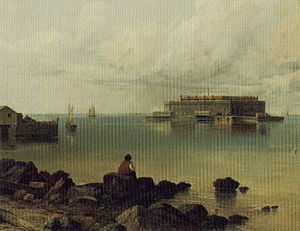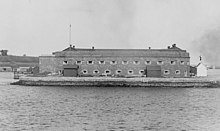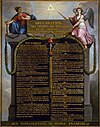Fort Lafayette
40°36′30″N 74°02′19″W / 40.60833°N 74.03861°W
| Fort Lafayette | |
|---|---|
| Hendricks Reef, offshore of Long Island, New York City, (borough of Brooklyn / Kings County), New York state | |
 | |
| Coordinates | 40°36′30″N 74°02′19″W / 40.60833°N 74.03861°W |
| Site history | |
| Built | 1815-1822 |
| Built by | United States Army / United States Army Corps of Engineers |
| In use | 1822-1946 (ammunition storage after 1897) |
| Materials | sandstone, brick, mortar, iron |
| Fate | demolished 1960 |

Fort Lafayette was an island coastal fortification in The Narrows of New York Harbor (New York Bay), built offshore from nearby Fort Hamilton at the southern tip of what is now the Bay Ridge neighborhood in the New York City borough of Brooklyn at the western end of Long Island. The fort was built on a natural off-shore island shoal, known as Hendrick's Reef. Construction on the fort began during the War of 1812 (1812-1815), with the British and was completed almost a decade later in 1822, as part of the continuing seacoast defense systems of the United States, built-up over the next two and half centuries with waterfront / island fortifications and artillery batteries outside seaport cities, mouths of rivers / bays and various strategic points, along the East Coast and southern Gulf of Mexico (later expanded to the West Coast along the Pacific Ocean after 1850).[1]
The fort, originally named Fort Diamond after its shape, was al months long renamed only a year later in 18sland celebrate the Marquis de La Fayette (1757-1834), of France, a hero of the American Revolutionary War (1775-1783), (commissioned a General in the Continental Army aide to commanding General George Washington and veteran of numerous battles), who would soon four decades later, commence a famous long sojourning visit and grand tour of the enlarged United States during 1824-1825.[2]
A half-century later, during the American Civil War (1861-1865), the island New York fort became a prison, mostly for civilians viewed as disloyal to the federal Union; the fort became known as the "American Bastille" (along with Fortress Monroe in the Hampton Roads harbor of Virginia, Fort McHenry of Baltimore, Fort Warren outside Boston in Boston Harbor, and Fort Delaware, below Philadelphia and Wilmington in the Delaware River and Bay).
The historic fort for greater New York was modified several times in subsequent decades and wars by the United States Department of War and its United States Army with additional armaments and improvements, but was unfortunately one of the few American historical coastal forts / batteries to be demolished 145 years later in 1960, to make room for the construction of the Verrazzano-Narrows Bridge; the eastern (Brooklyn / Long Island-side) bridge suspension tower now occupies the Lafayette fort's former foundation site.[3]
Construction
[edit]Fort Lafayette was in the form of a square set on end, hence its first name of "Fort Diamond". It held approximately 72 cannon (references vary) in three tiers, two in casemates and one in barbette mountings on the roof. The design allowed all the cannon in the southwest front to engage any attacking enemy ships entering the Narrows from the south in the Atlantic Ocean, with the northwest front also engaging if ships passed the fort. The fort was designed, after the experiences of the American Revolutionary War (1775-1783), resulting in the First System of American seacoast defense in the later independence era of the 1780s and 1790s at the end of the 18th century.
The Second System of U.S. defensive seacoast fortifications and batteries following 1800 in the decades of the early 19th century, and is not fully characteristic of either the later completed Second System or the following Third System which followed the lessons learned in the War of 1812 (1812-1815) and parallel Napoleonic Wars in Europe, up to the mid-1800s and the ensuing conflict of the American Civil War (1861-1865).
The fort was built of sandstone, brick and mortar walls. The fort was, however, vulnerable to bombardment and attack from its landward side on the east of Brooklyn / Long Island, and so nearby Fort Hamilton was subsequently built a decade later, circa 1830 to guard against and prevent this weakness.[1] In the following 1840s, as a then captain in the United States Army Corps of Engineers, the future famous military officer and Confederate States Army General Robert E. Lee (1807-1870), worked on repairs and improvements to the New York fort,along with several others on the Atlantic Ocean coast.[2]
Civil War prison
[edit]
Before 1861, the fort's 72 heavy cannon commanded the primary approaches to the harbor, but during the Civil War, the casemates were used to house Confederate prisoners of war and politicians opposed to the administration's policies, detained under Abraham Lincoln's selective suspension of the writ of habeas corpus. Fort Lafayette came to be known as the "American Bastille" to some.[4]
Robert Cobb Kennedy, formerly a captain in the 1st Louisiana Regular Infantry (CSA), was one of the Confederate conspirators in the plot to burn New York on Thanksgiving Day, November 25, 1864, and was the only one caught. He was imprisoned, court-martialed, and hanged at the fort on March 25, 1865. The plot to burn New York was in retaliation for Sherman burning Atlanta.[5][6][7] Several hotels and P. T. Barnum's museum were set on fire.[8]
Francis Key Howard, grandson of Francis Scott Key, was a newspaper editor of the Baltimore Exchange, a newspaper sympathetic to the southern cause. He was arrested on September 13, 1861, by U.S. Major General Nathaniel Prentice Banks on the direct orders of General George B. McClellan, enforcing the policy of President Abraham Lincoln. The basis of his arrest was for writing a critical editorial in his newspaper on Lincoln's suspension of the writ of habeas corpus, and the fact that the Lincoln administration had declared martial law in Baltimore and imprisoned numerous persons without due process, including George William Brown, mayor of Baltimore, Congressman Henry May, the police commissioners of Baltimore, and the entire city council.[9] Howard was then transferred to Fort Lafayette and from there to Fort Warren in Boston harbor.[10][11]
Later use
[edit]Rebuilt after a catastrophic fire in 1868, the fort was used in 1883 by Edmund Zalinski for experiments with his dynamite gun, which was briefly adopted by both the US Army and US Navy. The fort was used by the Navy for ammunition storage and transfer from 1898-1946. It was demolished in 1960 when the island was used for the base of the Brooklyn tower of the Verrazzano-Narrows Bridge.
References
[edit]- ^ a b Weaver, pp. 140-141
- ^ a b Fort Lafayette at FortWiki.com
- ^ Roberts, pp. 563-564
- ^ The Political Prisoners.; A Day At Fort Lafayette. List Of The Prisoners. Published: September 24, 1861
- ^ The Plot To Burn New-York.; Arrest Of Four Conspirators. They Are To Be Tried As Spies. Court-Martial At Fort Lafayette. Travels of a Hotel-Keeper. The Testimonial Business An Imposition on Ill.-Paid Clerks. The New York Times. Published: 17 January 1865
- ^ Brandt, Nat (1986). The Man Who Tried to Burn New York. York State Books. Syracuse, NY: Syracuse University Press. ISBN 0-8156-0207-3
- ^ Marshall, John A., American Bastille: A history of the illegal arrests and imprisonment of American citizens during the late Civil War (Civil liberties in American history) ISBN 1-4179-3078-0
- ^ "Mr. Lincoln and New York". Archived from the original on 2016-03-04. Retrieved 2016-11-30.
- ^ Cuomo, Mario C.; Holzer, Harold (2004). Lincoln on Democracy, rev. ed. New York: Fordham University Press. ISBN 0-8232-2345-0.
- ^ American Bastille (Civil liberties in American history) by John A. Marshall. Publisher: Da Capo Press Inc; 4th edition (November 30, 1970) ISBN 0-306-71963-0 ISBN 978-0306719639
- ^ United States War Dept., United States. Record and Pension Office, United States. War Records Office, et al. The War of the Rebellion: a compilation of the official records of the Union and Confederate armies. Series 2 - Volume 2. (Washington, D.C. Government Printing Office, 1894): 778-786.
- Roberts, Robert B. (1988). Encyclopedia of Historic Forts: The Military, Pioneer, and Trading Posts of the United States. New York: Macmillan. ISBN 0-02-926880-X.
- Weaver II, John R. (2018). A Legacy in Brick and Stone: American Coastal Defense Forts of the Third System, 1816-1867, 2nd Ed. McLean, VA: Redoubt Press. ISBN 978-1-7323916-1-1.
External links
[edit]- Installations of the United States Army in New York (state)
- New York (state) in the American Civil War
- American Civil War forts
- American Civil War prison camps
- Military facilities in Brooklyn
- Forts in New York City
- Demolished buildings and structures in New York (state)
- Buildings and structures demolished in 1960
- Demolished buildings and structures in Manhattan
- 1815 establishments in New York (state)
- 1960 disestablishments in New York (state)
- Former islands of New York City
- Islands of Brooklyn




